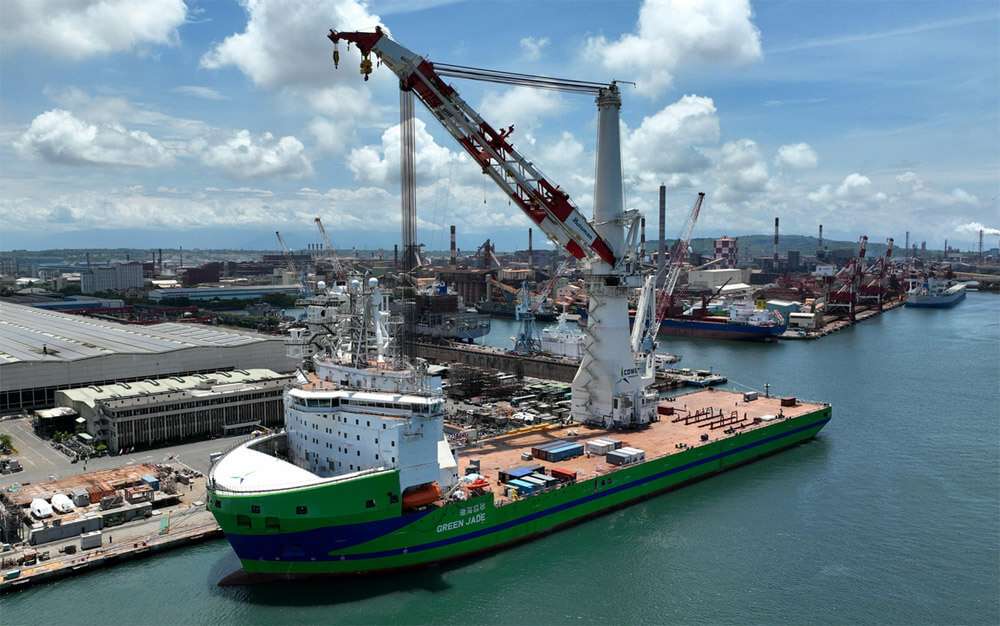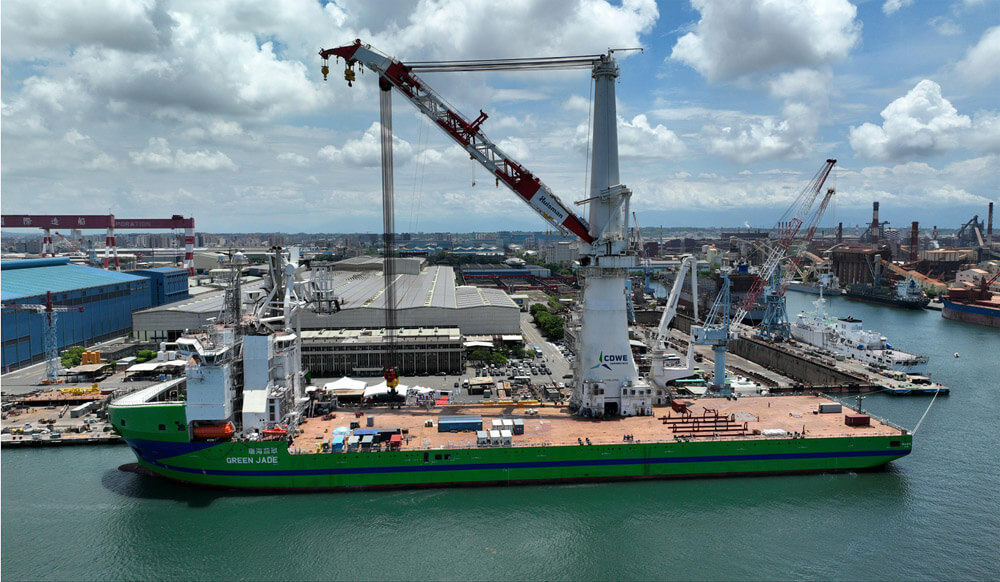Taiwan Commissions First Domestically-Built Large WTIV with DEME

Taiwan commissioned its first domestically-built wind turbine installation vessel which is also among the largest and most capable vessels in the emerging sector. Named Green Jade, the vessel was designed for the next generation of large wind turbines with a large loading capacity, lifting heights, and green technologies, that the owners emphasize will make it cost-effective and suited to address trends in the industry.
The new installation ship was officially dedicated on June 30 at the Taiwan Shipbuilding Company, CSBC shipyard in Kaohsiung, Taiwan, and is part of the government’s efforts to maximize the domestic content in the industry. The vessel is owned by CSBC-DEME Wind Engineering (CDWE) which was set up in 2019 as a partnership between CSBC and Belgium offshore company DEME. The partnership was formed so that Taiwan could draw from the experience of the European industry to build its domestic offshore wind sector. Taiwan commissioned its first offshore wind farm in 2019 and currently has four operating, the largest of which was developed by Ørsted with a total capacity of 900 MW.
Design for the installation vessel begin in 2019 drawing from DEME’s Orion, another of the largest specialized offshore wind installation vessels. Orion was delivered to DEME last year and is currently undertaking the installation for Vineyard Wind 1, which involves 62 foundations off about 13 nautical miles south of Martha’s Vineyard and Nantucket, Massachusetts. The construction order was confirmed for the Taiwanese vessel in 2020 after CDWE secured large offshore wind installation contracts in Taiwan.

CSBC highlights numerous challenges during the construction of the vessel. Green Jade is more than seven months behind the originally anticipated schedule in part due to the effects of the COVID-19 pandemic. The shipyard reports problems obtaining raw materials and price surges, European regulations, technical difficulties, exchange rate issues, and manpower shortages, as well as the challenges of a first-time construction. In addition to being the second largest wind power crane ship, they are saying Green Jade is also the most expensive commercial ship in the history of Taiwanese shipping. The shipyard is calling her the largest and most complex vessel that they ever built.
The massive vessel is 710 feet in length and approximately 60,000 dwt. According to the companies, the design of the vessel gives her the ability to transport multiple jackets and foundations in a single shipment. The vessel’s deck space was maximized to transport the heaviest monopolies, jackets, and wind turbine components and structures, with a total of 8,200 square meters of cargo area. The vessel has a 4,000-ton crane and a high lift capability. She has accommodations for up to 160 people.
Among the environmental considerations are dual-fuel engines. The vessel has a waste heat recovery system that converts exhaust gases and cooling water into electrical energy. There are also various fuel-saving measures.

Green Jade is scheduled to enter service in July and will initially be deployed for the installation of jacket foundations at the 298 MW Zhong Neng project located in the Taiwan Strait. CDWE signed two installation contracts with Zhong Neng Wind Power Corporation in late 2019, including for the 300 MW Zhong Neng project being developed by China Steel Corporation.
Work on Zhong Neng will be followed by the larger Hai Long wind farms, which are seen as a litmus test for Taiwan’s effort to develop offshore wind through its localization program. CDWE signed the deal for the project in November 2022, which calls for the installation of 73 wind turbines capable of generating 1,044 MW of power. The project will be located approximately 25 to 30 miles off the coast of Taiwan. Pre-piling work is scheduled to start in 2024.
CDWE reports that the vessel will also be available for projects in neighboring Southeast Asian countries.
